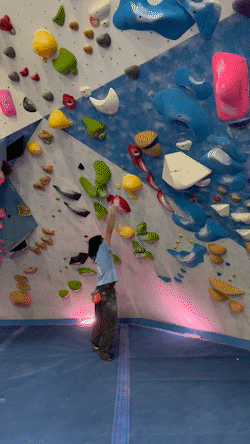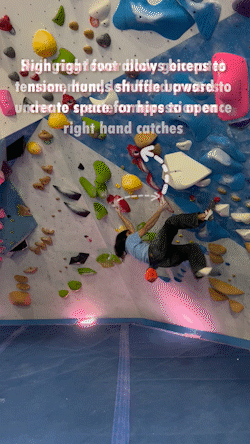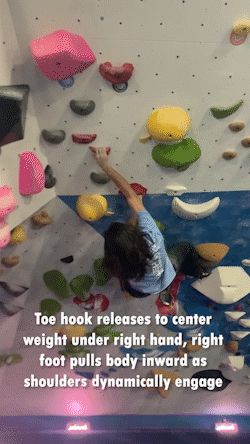Breakdown
Climber: Sid Pinto 5’9”/+1
Wall Angle: 45° Overhang
Holds: eGrips Wonder Pockets, Flathold Electric Flavour, Rock Candy Crispy Jugs
RIC: Risk 1, Intensity 4, Complexity 3
The movement on this boulder focuses on body tension and lock-off strength. Intensity is ranked high because it is pivotal for the climber to keep core engagement to control body positioning. There is an emphasis on finger strength and the boulder will become more difficult if the climber is not using their lower body to properly manage the stress on their fingers. Complexity is present because there are a few different options to navigate through the main sections of the boulder. Hand and foot sequences can be performed in different ways depending on the climber’s strengths and preferences. Risk ranks low because none of the movements are distinctly low-percentage.
Influence/Aesthetic:
This is another boulder that I tried to replicate from Instagram. The main movement is the campus swing after the first pocket, albeit there is an alternate toe hook beta in my version. I took this movement and set the remainder of the boulder around it. The continuous use of pockets and large sweeping movements help to develop an overall theme for the boulder. Aesthetically the primary theme is that all of the holds share an earthy texture. There is also a straight line of holds in the middle of the boulder that helps to denote a small change to less dynamic movement. However, I wouldn’t say there is a strong aesthetic motif with this climb.
Hold Selection:
The holds to note for this boulder are the pockets. Pockets are a useful tool to place climbers in positions that they only have one way out of. This can help to encourage specific hand or foot sequences like rose moves, crosses, toe hooks, and heel hooks. They also reward proper route reading and performance because if the climber goes to them with the wrong hand, it can be difficult to fix their trajectory. The remainder of the holds contrasts the pockets as they are rather positive jugs but feature a high degree of directionality to keep within the theme of thoughtful sequencing and body positioning.
Big Swing
Sid begins the boulder by rocking his lower body to gain leftward momentum.
He crosses his left hand under before releasing his right hand to the far right sidepulling jug.
Placing his left hand before gaining the right hand allows him to immediately engage his shoulders and create compression.
Sequential Shuffle
Sid gets a high right foot to generate more traction for bicep engagement. This releases weight from his left hand and allows his hips to center under the line of sidepulls.
He begins to shuffle his hands upward so he is able to gain the pocket with his right hand. If he gains it with his left he will be out of sequence and be unable to continue the boulder.
Once his right hand is in the pocket his hips are open enough to begin utilizing his left foot again.
Lock-on, Lock-off
Sid brings his left foot up and drops his left hip inward as he moves toward the next pocket. This twisting motion shortens the distance he has to travel while keeping his core engaged.
He then walks his feet up and sets a right heel hook to stabilize his body for the next crossover move.
Taking the Top
Sid’s right heel hook prevents his hips from falling too far outward as he crosses overhead to gain the next right hand.
He releases the heel hook and places a right toe to shift his weight underneath his right hand and improve engagement.
This allows him to release his right hand from the pocket and shift his weight over his right foot and pop upward to gain the finish.
Final Thoughts
Although Sid does this boulder with the intended beta for the video, there is a way to do it that has a similar sequence but climbs much more static. It is possible to throw a toe hook on the far right hold in the first pocket sequence and reach it with control. Setting new moves often takes a couple of iterations to perfect but for the first attempt, we were satisfied. Setting nuanced dynamic moves is always challenging because there are so many factors like wall angle, distance between holds, and hold type. After forerunning we came to the conclusion that more sloping sidepulls could prevent the climber from toehooking. Additionally, the distance between the holds could increase slightly to encourage more dynamic movement. For a commercial setting, we felt that the toe hook added a bit more accessibility to the move so we left it as an option. Replicating this move again in a commercial or competition environment will be easier with the knowledge from this trial run.




